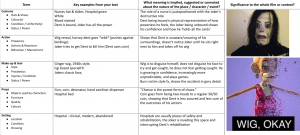The Captain’s Feast establishes the nature of the fascist ruling class in rural Spain and the attitudes and values of Captain Vidal, the villain in the film. The feast is a scene of indulgence, greed and power. Vidal is a fascist brute, he is proud of his reputation and dominates the scene. The guests are hypocrites and prove to be arrogant, patronising and snobbish. Carmen, seems out of place and is represented as fragile, elegant and intimidated by the other guests, we also get the impression that Vidal does not care for her.
Below is our class’ slideshow analysis the mise-en-scene of various aspects of the Captain’s Feast, where we analysed the setting and the characters in pairs. The Captain dominates the scene, he is sat at the head of the table and his behaviour is brash and inconsiderate – he feels no need to schmooze his guests, his power is enough. This power is displayed through his clothing, he wears his captain uniform with all of his medals to show off his prestige. He appears to wear no make up and his hair is gelled back, representing his masculinity and meticulousness.
Carmen wears the brightest colour out of everyone, so she stands out among the guests and maids who are all clad in darker colours. This could symbolise both her purity and status (paler clothing is harder to keep looking neat and maintained). Her face also reflects the warm glow of the fire, showing her warmth and compassion which the other guests seem to lack (the guests talk lightly, almost jokingly about the reduction in rations). She is also in wheelchair, highlighting her weakness in comparison to her husband. When the guests stand in respect as she leaves the room it appears to have the opposite affect on her as she averts her eyes. At one point Carmen places her hand atop of her husband’s and he takes it back quickly, showing that he doesn’t want to bother keeping up the facade of being a happy family whereas Carmen is trying not to lose face.
The main source of light in the room is the fireplace (there’s no candles, showing that this a cold, unaffectionate dinner) and Captain Vidal sits directly in front of it, another display of dominance. The maids are easily distinguishable from the guests as they all wear white aprons, a contrast from the dark clothing of the guests. The guests dine lavishly, consuming meat and wine moments after discussing the new rationing plans, this demonstrates the greediness and apathy of the wealthy. The mood is slightly tense despite the food and wine, this is contrasted with the more comfortable vibes of the kitchen where the workers sit close together as they work and show concern for Mercedes as she rushes outside.

